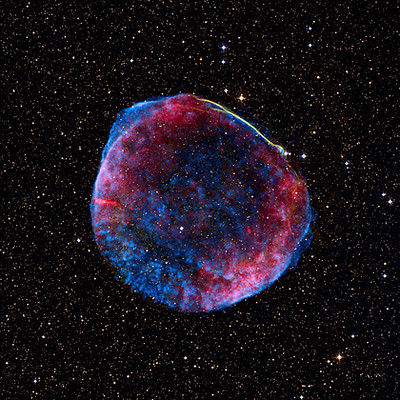The Sequence of Star Life Cycle | A Star become unstable
Main Sequence Phase(Stars like our Sun)
A STAR converts HYDROGEN ATOMs into HELIUM during its lifetime. If a star is big enough to convert HYDROGEN ATOM into helium, it will enter the phase our SUN is in, called the MAIN SEQUENCE PHASE. When a main-sequence STAR ignites, the hydrogen in its core is converted to helium through NUCLEAR FUSION.
When the core's supply of HYDROGEN begins to run out and the main sequence star no longer generates heat through NUCLEAR FUSION, the core becomes unstable and shrinks. Eventually the core runs out of HYDROGEN, and THE SUN begins to evolve off the MAIN SEQUENCE. Later, when the majority of the atoms in the core become helium, STARs LIKE THE SUN begin to fuse hydrogen along the spherical shell surrounding the core. The temperature and pressure at the center of the star will eventually reach a point where helium can be melted into carbon.
Massive Stars
HELIUM bursts occur if the core is primarily supported by electron degenerate pressure (stars with a solar mass less than 1.4) when the core temperature and pressure are high enough to trigger helium melting. In massive stars, at the onset of the hydrogen-burning envelope, the core is large enough that helium ignition occurs before the electron degenerate pressure has a chance to become dominant. In stars more massive than the Sun, it can take a billion years or more for the core to reach the ignition temperature of helium.
Red Giant
A STAR with the MASS of our sun has no gravitational pressure to melt carbon, so once it runs out of helium inside it, it effectively dies. Once stars five times the mass of the SUN reach the RED GIANT stage, their internal temperatures rise as helium atoms fuse to form carbon atoms. Eventually, the temperature of the star's core will reach a temperature at which the core can begin to melt.
The contract heats the hydrogen shell around the core, which then ignites in fusion, causing the star to glow again 1,000 to 10,000 times. When all the hydrogen is used up in the fusion process, larger nuclei begin to form, and the star can expand into a red giant. Fusion at its core is a process all stars go through, converting hydrogen protons in various stages into helium atoms. The melting of its core is exothermic; it emits so much heat that the core of a main-sequence star, the main-sequence star, releases a lot of energy.
Depending on the mass of the helium core, this continues for several million, one or two billion years, while the star expands and cools with a brightness close to or slightly less than its state on the main sequence. After launch, stars develop differently depending on their size. All stars, no matter their size, follow the same 7-step cycle, starting with a cloud of gas and ending with the remnant of a star.
Red Dwarf
The MASS of these stars can range from about one-tenth that of our Sun to as much as 200 times that, and its size determines how long the star stays in the main sequence phase. The smallest stars, about eight times the mass of our Sun, can become white dwarfs. Less massive stars, such as red dwarfs with half the mass of the Sun, can consume the fuel of less massive stars for hundreds of billions and even trillions of years. Stars smaller than the Sun do not have enough mass to burn only red during their main sequence.
Supernova
Supermassive stars (greater than 40M) are very bright and therefore have very fast stellar winds, and due to radiation pressure, they lose mass so rapidly that they tend to tear apart their outer shells before expanding and becoming red supergiants. Thus maintaining extremely high surface temperatures (and bluish-white) from their main sequence. If a few stars are large enough, say five times the mass of an average star like the sun, the red giant phase collapses into a huge explosion called a supernova. The star then becomes a red giant, a phase that only lasts about 10%, based on the proportion of such stars we see in the cluster. When massive stars expand and cool, they don't suddenly light up like less massive stars; however, they are brighter on the main sequence and evolve into very bright supergiants.
Supernova explosion
Massive stars explode into supernovae, neutron stars and black holes, while mid-sized stars like the Sun end their lives as a white dwarf surrounded by a fading planetary nebula. Depending on the mass at the beginning of the supernova explosion, the supernova will leave behind a neutron star or a black hole. The core of a massive star, more than 3 times the mass of our Sun, will behave completely differently after a supernova explosion.
Even more interesting, if the collapsing star is huge, say eight times the mass of our Sun, the supernova is so intense that it creates a black hole, a tiny object with a huge gravitational field. Less massive stars do not explode, instead their cores shrink into a small, hot star known as a white dwarf as the outer material is removed. When high-mass stars run out of fuel to generate energy outward, their iron cores begin to collapse until the pressure exceeds the internal pull of gravity, and explode in a spectacular supernova, scattering elements into space to recombine into future stars, planets, asteroids. , or even end up living the way we do. A star with a core mass that is too large to form a white dwarf but not enough to long-term convert neon to oxygen and magnesium will burn its core (due to electron capture) before the heavier elements can melt.


0 Comments